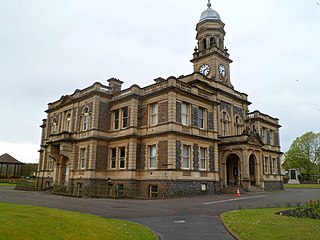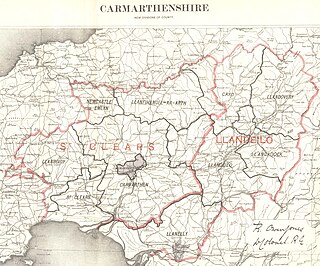Related Research Articles

Llanelli is a market town and community in Carmarthenshire and the preserved county of Dyfed, Wales. It is located on the Loughor estuary and is the largest town in the county of Carmarthenshire.
The Llanelly Railway and Dock Company was an early Welsh railway system. It opened its first short line and a wet dock at Llanelly in 1834, and soon went on to build a longer line from Llanelly to serve pits in the Amman Valley, and then on to Llandilo, reached in 1857. The Llanelly company leased and worked the Vale of Towy Railway on to Llandovery, from 1858.
This article is a timeline of Llanelli history. For a full article on the town, see Llanelli.

East Carmarthenshire was a county constituency in Carmarthenshire, Wales. It returned one Member of Parliament (MP) to the House of Commons of the Parliament of the United Kingdom, elected by the first past the post voting system.

West Carmarthenshire was a parliamentary constituency in Wales which returned one Member of Parliament (MP) to the House of Commons of the Parliament of the United Kingdom.

The Reverend David Rees was a Welsh Congregational minister of Capel Als chapel Llanelli, Carmarthenshire, and an editor of a radical Welsh language Nonconformist periodical titled Y Diwygiwr. Known as 'Y Cynhyrfwr', he held radical political views and opposed the relationship between the Established Church and the state.

The Kidwelly and Llanelly Canal was a canal and tramroad system in Carmarthenshire, Wales, built to carry anthracite coal to the coast for onward transportation by coastal ships. It began life as Kymer's Canal in 1766, which linked pits at Pwll y Llygod to a dock near Kidwelly. Access to the dock gradually became more difficult as the estuary silted up, and an extension to Llanelli was authorised in 1812. Progress was slow, and the new canal was linked to a harbour at Pembrey built by Thomas Gaunt in the 1820s, until the company's own harbour at Burry Port was completed in 1832. Tramways served a number of collieries to the east of Burry Port.
The Llanelly and Mynydd Mawr Railway was authorised in 1875. It made use of part of the long defunct Carmarthenshire Railway or Tramroad of 1801. The older line began running trains in 1803, and was a plateway of about 4 feet gauge, with horse traction, for the purpose of bringing minerals from the Mynydd Mawr to the sea for onward shipment at Llanelly Docks.
This is a list of High Sheriffs of Carmarthenshire. Carmarthenshire was originally created by the Statute of Rhuddlan in 1284. It became an administrative county in 1889 with a county council following the Local Government Act 1888. Under the Local Government Act 1972, the administrative county of Carmarthenshire was abolished on 1 April 1974 and the area of Carmarthenshire became three districts within the new county of Dyfed : Carmarthen, Dinefwr and Llanelli. Under the Local Government (Wales) Act 1994, Dyfed was abolished on 1 April 1996 and the three districts united to form a unitary authority which had the same boundaries as the original Carmarthenshire but remaining in the shrievalty of Dyfed.

William Buckley Roderick was a Welsh solicitor, international rugby union forward and later a Vice-Consular for Spain. Roderick played club rugby for Llanelli Rugby Football Club and international rugby for Wales.
The bank officially known as the Aberystwith and Tregaron Bank was established at Aberystwyth, Cardiganshire in the beginning of the 19th century and was locally known as ‘Banc y Ddafad Ddu’, because the bank notes were imprinted with an engraving of a black sheep. The bank later established a branch at Tregaron.
The Carmarthen Furnace Bank is a bank established in Carmarthenshire in the 18th century as a result of the efforts of a Welsh entrepreneur and businessman called John Morgan. The banking business started by issuing tokens to facilitate an iron and tin works operation and then developed into a full-fledged bank. However, few records of the works, or the bank, exist.
The Llandovery Bank was established in 1799 in Llandovery, Wales, in the premises known as the King’s Head on Stone Street, where it remained for many years. The bank was locally known as the ‘Black Ox Bank’ because of the bank notes having been embellished with an engraving on the left hand side of a Welsh black ox.
David Morris & Sons was a bank which was established in Carmarthenshire, Wales in the 18th century. It now a constituent part of The Royal Bank of Scotland Group.
Carmarthen Bank was a bank established and formerly operated in the county of Carmarthenshire, Wales during the 19th century. It became bankrupt in 1832 and its name was then adopted by another Carmarthenshire-based bank.
George Haynes (1745–1830) was a British entrepreneur, pottery manufacturer, banker, and newspaper proprietor of Swansea, Wales.

Sir John Stepney Cowell-Stepney, 1st Baronet, KH (1791–1877) was a British soldier, landowner and politician. He was the elder of the two sons of General Andrew Cowell, originally of Coleshill, Buckinghamshire, and his wife Maria Justina, youngest daughter of Sir Thomas Stepney, 7th baronet of Prendergast, Pembrokeshire, and Llanelly House, Carmarthenshire. He was known as [John] Stepney Cowell until he inherited the Stepney family's estates in 1857 under the terms of the will of his uncle, Sir John Stepney, 8th baronet, when he changed the family's name to Cowell-Stepney.

Edward Haycock Sr. was an English architect working in the West Midlands and in central and southern Wales in the late Georgian and early Victorian periods.
The 1876 Carmarthen Boroughs by-election was fought on 14 August 1876. The by-election was called following the resignation of the incumbent Conservative MP, Charles William Nevill. It was won by the Liberal candidate Arthur Cowell-Stepney, who was returned unopposed.
The first election to the Carmarthenshire County Council was held in January 1889. It was followed by the 1892 election.
References
- ↑ House of Lords the Sessional Papers 1801-1833 Retrieved 27 September 2009
- 1 2 3 Early Banks in West Wales, by Francis Green (in West Wales Historical Records, The Annual Magazine of The Historical Society of West Wales, Volume VI, edited by Francis Green, Printed by W. Spurrell & Son, 1916)
- ↑ This is probably the note of 1823 with serial number 600 illustrated in Hughes, Gareth (1984). A Llanelli chronicle. Llanelli Borough Council. p. 12. ISBN 0-906821-02-9..
- ↑ "The World's Premier Online Auctions". www.artfact.com. Retrieved 27 September 2009.
- ↑ "Lot 504: [ Paper Money ] Llanelly Bank". www.invaluable.com. Retrieved 27 September 2009.[ title missing ]